
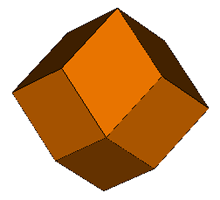
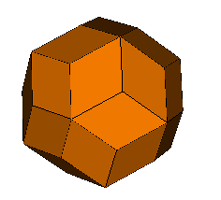
Isogonal Rhombihedra
This page is the result of a collaboration between Jim McNeill and Mason Green
In this page we explore the possibilities for isogonal rhombihedra, i.e. polyhedra which are face transitive and consist of rhombic faces. In total we present 12 examples, of which we believe the last 3 to be new discoveries.
Duals to Uniform Polyhedra.
 |
 |
 |
Three examples are well known: the cube (and it's range of rhombic isomorphs, examples 1 and 2), the rhombic dodecahedron (dual to the cuboctahedron) and the rhombic triacontahedron (dual to the icosidodecahedron).
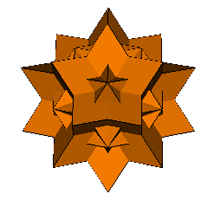 |
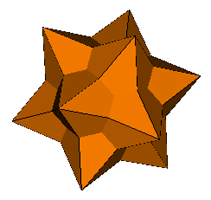 |
Two further examples occur amongst the duals to the uniform polyhedra, the great rhombic triacontahedron (dual to the great icosidodecahedron) and the medial rhombic triacontahedron (dual to the dodecadodecahedron).
Rhombified Duals to Uniform Polyhedra
A number of other uniform polyhedra which have tetragonal vertices (four faces meeting at each vertex) have duals containing irregular quadrilateral faces. In a number of cases, these faces can be deformed to rhombi whilst retaining the same polyhedral net. The face transitivity of the faces is preserved.
Those uniform polyhedra meeting the above criteria and the rhombified isomorphs of their duals are given in the table below.
Notes:
(1) above, has the rhombi coplanar in sets of three and is a stellation of the icosahedron that superficially resembles a great icosahedron
(2) to (4) are all stellations of the rhombic triacontahedron, (2) and (3) are superficially similar but differ in their internal structure, as can be seen from exploring the 'translucent' and 'frame' modes of the VRML files.
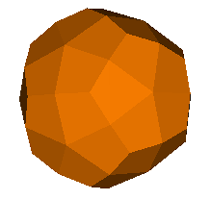 |
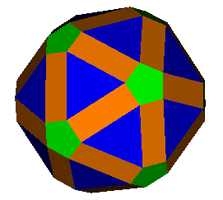 |
(5) to (7) are all stellations of a strombic figure that is dual to a rhombicosidodecahedron (both shown above) where the ratio of the lengths of the triangular and pentagonal edges is phi+1 to 1. We believe these rhombihedra to be new discoveries.
Credits
The original dual figures were produced using Great Stella and relaxed using HEDRON.
Back: To Deltahedra and Rhombihedra